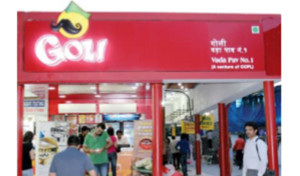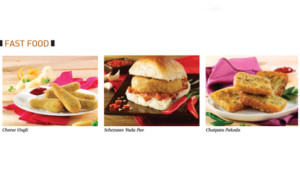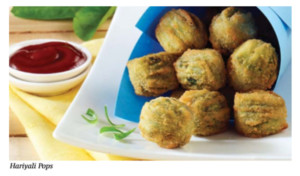Co-founder & CEO, Goli Vada Pav, Venkatesh Iyer, has taken the quintessential Mumbai vada pav to every nook and corner of the country and has made GVP one of the most successful Indian ethnic QSR chains. In a no-holds-barred conversation with Manisha Almadi Midha, he shares his strategy for growth…
Tell us about your transition to the QSR industry.
I worked in the banking industry for four years and set up a corporate finance company to raise funds for corporates. At the same time, I also noticed the entry of global giants like McDonald’s, Pizza Hut and Domino’s in the QSR category in India. More than a decade ago, there were hardly any Indian brands present in the QSR or food category, those who were, they were not at the scale matching their international counterparts.
 Shivadas Menon, my partner and I were struggling to fi nd an answer to my questions when one day it just hit in our faces. We were coming back from a meeting via Mumbai local and got off at CST station. With both of us famished, we headed to a nearby vada pav stall, which was outside McDonald’s. When I took a bite of my vada pav that day, I noticed a 40-ft. tall McDonald’s burger hoarding and it just hit me that vada pav and American burger are twin brothers. Vada pav is a finger food with a pan-India appeal.
Shivadas Menon, my partner and I were struggling to fi nd an answer to my questions when one day it just hit in our faces. We were coming back from a meeting via Mumbai local and got off at CST station. With both of us famished, we headed to a nearby vada pav stall, which was outside McDonald’s. When I took a bite of my vada pav that day, I noticed a 40-ft. tall McDonald’s burger hoarding and it just hit me that vada pav and American burger are twin brothers. Vada pav is a finger food with a pan-India appeal.
What challenges did you face while setting up Goli Vada Pav?
We implemented a hub and spoke model where we set up a central kitchen at our fi rst store in Kalyan, Mumbai in 2004 to prepare raw vadas which were supplied to the stores from there. Within a month of opening our store, we received 150 franchise enquiries.
 Over the following two-three months, 20 stores were opened in Kalyan and nearby suburbs. We realised we have to change our business model as we faced problems in expanding outside the region. We decided to try IQF (Individual Quick Freezing) technology used by a leading global fast food chain in the world.
Over the following two-three months, 20 stores were opened in Kalyan and nearby suburbs. We realised we have to change our business model as we faced problems in expanding outside the region. We decided to try IQF (Individual Quick Freezing) technology used by a leading global fast food chain in the world.
After a year, they agreed to start preparing raw vadas for us in their automated plant. With this tie-up, we solved all our challenges — the vada pav’s shelf life improved with fi xed expiry date and batch trail, wastage was less; the taste got standardised and would not differ every time the chef changed; and the product could not be pilfered.
GVP is currently prepared in a fully automated plant, where every stage in the preparation — right from cutting, slicing and packing is automated, which saves time, helps cut down on waste and is hygienic as it avoids manual handling of food and packaging.
The vadas are prepared and shipped across the country via a cold storage partner. Our plant is HACCP (Hazard Analysis and Critical Control Points) certified. If a businessman takes our franchise and he was to do local sourcing and production, there would be price fluctuations in six months, and different kinds of problems would arise.
 The key for any ethnic fast food chain to go national is standardisation of the product, and offerings that have a national appeal and low pricing.
The key for any ethnic fast food chain to go national is standardisation of the product, and offerings that have a national appeal and low pricing.
In Mumbai, you can get a vada pav for anywhere between Rs 7 to Rs 40. Our price range starts from Rs 25 onwards. The city sells an estimated 20 lakh vada pavs every day, of which five per cent comes from organised players with a national presence.
You are looking at a pan-India presence…
Our aspiration was to introduce vada pavs to people who had never even heard of it. Thus consciously, we decided to expand outside Mumbai and Pune to regions like interior Maharashtra, and South India. When we looked for investors in 2007, they felt thism business can’t be organised.
 As we entered 2008, economic slowdown hit us. Just when we thought, it’s time to pull down the curtains we got a call from a Nashik customer to enquire about franchise procedure of the company. And just like that GVP was back in business. The success of this single store resulted in opening 12 stores in Nashik in a span of few months.
As we entered 2008, economic slowdown hit us. Just when we thought, it’s time to pull down the curtains we got a call from a Nashik customer to enquire about franchise procedure of the company. And just like that GVP was back in business. The success of this single store resulted in opening 12 stores in Nashik in a span of few months.
Today, the interior Maharashtra region is a big market for us with more than 100 stores in Nashik, Aurangabad, Beed, Nagpur Jalna, Parbhani, Akola, Amravati, Chandrapur, Yavatmal and more.
We have first-mover advantage in most of the cities where we started operations. While deciding on future expansion plans of Goli, we had a choice of entering either Gujarat or the South market. While everyone we consulted opted for a big market like Gujarat, my gut said Karnataka.
Today Bangalore is our top performing market and contributes 50 per cent of the total business. We have taken our product to all four corners of the country and we are present in Raipur, Jamshedpur, Kolkata, Darbhanga, Porbandar, Ahmedabad, Kochi and Hyderabad. We have opened new outlets in Bhilwara, Bhubaneswar, Faridabad, Dalhousie, Dhanbad, Ludhiana, Mohali, Pali, Agra Shimoga, Gorakhpur, Jodhpur and Bhusawal over the last six months.
GVP has established a pan-India footprint with more than 350 stores in 19 states and 88 cities. We will grow via an Omni-channel approach.
 We plan to penetrate into the untapped markets by going from 350 stores to 1,000 stores in the next five years. The company has signed up with master franchises for Tamil Nadu and Pondicherry and plans to open 200 new stores by 2020 in these two markets.
We plan to penetrate into the untapped markets by going from 350 stores to 1,000 stores in the next five years. The company has signed up with master franchises for Tamil Nadu and Pondicherry and plans to open 200 new stores by 2020 in these two markets.
Our strategy is to open 100 stores each in big cities like Chennai, Lucknow, Delhi/NCR and states such as UP, Punjab and Kerala. As Goli has grown, we have learnt vada pav has a universal appeal. We want to grow and become a global brand.
We are located in high streets, market places, railway stations, outside homes, offices and colleges because these places have the maximum crowd.
Suddenly if I put Goli in highways or malls, where people go once in three-four months, food habits will not be formed. As of now, you will not see us in malls.
Does GVP operate on a franchise model?
 We are a franchise led business, where we help our partners to set up the store, train the staff, audit their sales, help with marketing and identify unexplored areas where they can serve vada pavs. Currently, we serve seven variants — Classic Vada Pav, Aloo Tikki Vada Pav, Cheese Vada Pav, Mixed Vegetable Vada Pav, Schezwan Vada Pav, Masala Vada Pav and Makai Palak Vada Pav along with side dishes like Cheese Ungli, Sabudana Vada and Hariyali Pops besides meals.
We are a franchise led business, where we help our partners to set up the store, train the staff, audit their sales, help with marketing and identify unexplored areas where they can serve vada pavs. Currently, we serve seven variants — Classic Vada Pav, Aloo Tikki Vada Pav, Cheese Vada Pav, Mixed Vegetable Vada Pav, Schezwan Vada Pav, Masala Vada Pav and Makai Palak Vada Pav along with side dishes like Cheese Ungli, Sabudana Vada and Hariyali Pops besides meals.
We try to retain the flavour which is popular in major regions. Like, Classic Vada Pav has authentic Mumbaiya taste while Masala Vada Pav will remind you of a Samosa. Similarly, Makai Palak Vada Pav was launched after we saw its ingredients being popular down South Goli stores are typically 200-250 sq ft and are manned by a staff of three.
Unlike a fine dine restaurant, we don’t have air conditioning and
seating area. Our proposition to the customer is ‘Take it on the go’. These things help us keep our costs in check and we are able to serve more customers in less time. That’s the reason, our franchise break even within three-five months of operation.
 Recently, we have introduced operating franchisee model too. Many of our franchisees want to invest in Goli stores but do not have the time to run it so we help them by identifying and training operating franchisees who will take on the day-today operations for our investor franchisees.
Recently, we have introduced operating franchisee model too. Many of our franchisees want to invest in Goli stores but do not have the time to run it so we help them by identifying and training operating franchisees who will take on the day-today operations for our investor franchisees.
We also plan to get into small kiosks of 75 sq ft with one staff manning it and serving just vada pavs. Recently, we rolled out Goli’s mobile app for home delivery orders, for select stores in Bangalore. We will take this offering to our customers in Pune, Mumbai, Nashik, Kolkata, Gurgaon, Faridabad, Nagpur and Hyderabad in the next one year.
We have launched Golivadapav.com for placing online orders. We are also in talks with major food portals for last-mile delivery tie- ups.
What kind of investment has gone into GVP and what is the annual turnover?
In 2008, we raised Rs 5 crore from Jerry Rao and received Rs 21 crore from Ventureast in 2011. We closed the 2015 fiscal year with revenue of Rs 55 crore.
How are you coping with Indian and global QSR chains?
Vada pav is Mumbai’s most loved street food, but they are being served by unorganised players with no standardised taste and hygiene. We are competing to get a pie of customers’ palette which has so far been dominated by the likes of burgers, pizzas, pastas and desi flavours such as idlis, dosas, paranthas and samosas.
International QSR chains entered India in the 90s and continue to dominate the market. Indian QSRs are using technology and opening smaller format stores thus generating more revenue and are able to challenge international QSRs.
From the investors’ perspective, QSR and food service companies come in top three investment favourite sector safter e-commerce and technology. QSRs form 45 per cent of the F&B market. The market for QSR is around Rs 92,000 crore and is estimated to grow at an annual rate of 16 per cent.
While deciding on expansion Iyer chose Karnataka instead of Gujarat, and today Bangalore is their top performing market, contributing to 50 per cent of the total business
Must Read



